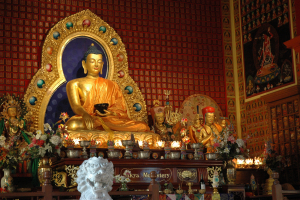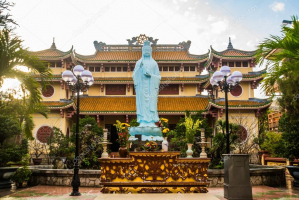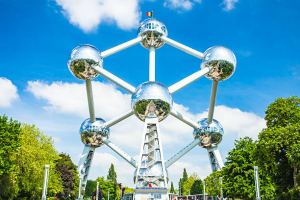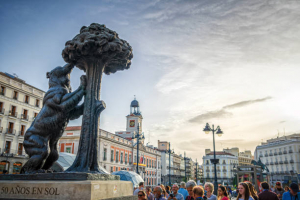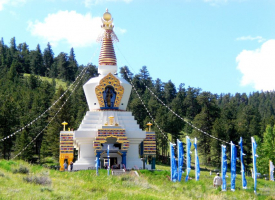Top 10 Most Amazing Buddhist Monasteries
One of the most important aspects of Buddhism is monasticism. Buddhist teachings must be preserved and disseminated, and followers must be instructed and led ... read more...by monks and nuns. Vassa, the retreat practiced by Buddhist monks and nuns during the South Asian rainy season, is where Buddhist monasteries first appeared. Over time, these monasteries transformed into places of study where philosophical ideas were created and discussed. And here are the most amazing Buddhist monasteries.
-
One of China's most amazing vistas is the Hanging Monastery, which is perched dangerously halfway up a cliff and is 75 meters (246 feet) above the earth. This amazing monastery, which consists of a network of 40 chambers connected by walkways and mid-air corridors, seems to be bonded to the edge of a high cliff. Although it is really supported on stilts rather than being built into a cliff, the label "hanging" may be deceptive. The monastery has hung here for 1500 years and dates back to the fifth century. Its current scale is the result of several repairs and extensions made during its lengthy existence.
The statues of Laozi, Confucius, and Shakyamuni, the three principal founders of Taoism, Confucianism, and Buddhism, respectively, that stand side by side in the Hanging Monastery are its most notable feature. The Hanging Monastery operated as a journey lodge, or a rest stop, for travelers because of its distant position. The Hanging Monastery entrenched China's three main faiths so that more tourists may remain there because religion was pervasive at the time and people were unwilling to stop at sites that worshipped a different religion. The Hanging Monastery consists of two pavilions, a bridge, and 40 halls. It’s 32 meters long in total.
Location: Hunyuan County, Datong City, Shanxi Province, China

https://www.istockphoto.com/ 
https://www.istockphoto.com/ -
Bhutan's upper Paro valley is home to the revered Vajrayana Himalayan Buddhist shrine known as Paro Taktsang (Paro Taktsang). One of the thirteen Tiger's Nest caves in ancient Tibet where Padmasambhava taught and practiced Vajrayana. Around the Taktsang Senge Samdup cave, where Guru Padmasambhava pondered and practiced with followers like Yeshe Tsogyal before leaving the Tibetan monarchy in the early ninth century, a subsequent monastery complex was constructed in 1692. Bhutan's tutelary god, Padmasambhava, is credited with bringing Vajrayana Buddhism to Bhutan, which was formerly a part of Tibet. Of the thirteen taktsang, or "tiger lair", caves where he and his followers meditated, Paro Taktsang is currently the most well-known.
The Padmasambhava shrine, also known as Gu-ru mTshan-brgyad Lhakhang or "the Shrine of the Guru with Eight Names", alludes to Padmasambhava's Eight Manifestations. It is a beautiful building that Gyalse Tenzin Rabgye erected around the cave in 1692. It has evolved into Bhutan's national symbol. In the Paro valley, a well-liked event called the Tsechu is conducted in honor of Padmasambhava sometime in March or April. All adult visitors to Taktshang will be required to pay an admission charge of 2,000 Nu beginning on September 23, 2022, after the modification of Bhutan's visa policy in July 2022. Only Bhutanese will be permitted to visit Taktshang on certain dates designated on the Bhutanese lunar calendar under the same revision.
Location: Paro Valley, Paro District, Bhutan

https://www.istockphoto.com/ 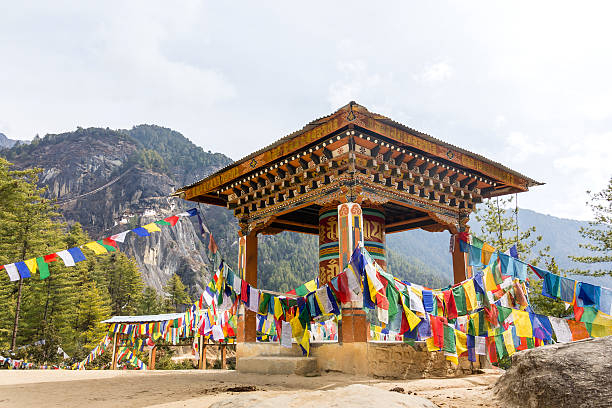
https://www.istockphoto.com/ -
Taung Kalat has a significant religious connotation. The same-named mountain, which was formerly a volcano, is where the monastery is situated. This truth is directly connected to monks' beliefs and is reflected in the fables that are told about the temple. Particularly, it is said that this volcano is home to natami spirits or living spirits. They are considered demigods by the locals. They formerly served as exemplars of the old nobility, whose veins were filled with royal blood. They were all slain, but at relatively different times and under quite different conditions.
Many pilgrims who fervently believe in the existence of nata provide the spirits with gifts of raw meat in an effort to coax them and get their sort of blessing in a variety of situations. By the way, if you are prone to superstitions as well, it may be worth your while to visit the monastery and ask the spirits for guidance while wearing red or black clothing, as these are said to be the nats' preferred hues. Two festivals, Nyon and Nada, are now conducted in May and November at the Buddhist monastery of Taung-Kalat in remembrance of these spirits.
Taung Kalat stands at the topmost summit of a dormant volcano from long ago. The peak rises barely over 700 meters. In the late XIX and early XX century, the monastery was constructed. The monk Wu Khandi is recognized as having contributed significantly to the temple's construction. By the way, the Golden Stone, a once-famous icon of Myanmar, was restored as a result of his work and efforts. 777 stairs lead to the temple. To reach a Buddhist god with pure ideas, each pilgrim must climb this ladder and cleanse his thoughts while being filled with harmony.
Location: Mandalay Region, Myanmar

istockphoto.com 
istockphoto.com -
The administrative hub of Punakha District is the Punakha Dzong, also known as Pungthang Dewa chhenbi Phodrang, or "the palace of tremendous happiness or bliss", in Punakha, Bhutan. The second oldest and second largest dzong in Bhutan was built by Ngawang Namgyal, the first Zhabdrung Rinpoche, in 1637–1638 and is considered one of its most gorgeous buildings. The Rangjung Kharsapani, the holy remains of Ngawang Namgyal and the tertön Pema Lingpa, as well as other precious artifacts from the southern Drukpa Lineage of the Kagyu school of Tibetan Buddhism, are all kept in the dzong. Up until 1955, when the capital was transferred to Thimphu, Punakha Dzong served as Bhutan's administrative hub and seat of the government. In Bhutan's Tentative List for UNESCO Inclusion, it is designated as a tentative site.
The Dzong hosts the yearly Domche festival, which is heavily attended by residents of the district's remote villages. During the festival, the Zhabdrung's ranghung "self-created" Avalokitevara picture, which is housed in the dzong's utse and was imported from Tibet, is on exhibit. There are some pretty magnificent performances during this five-day celebration, also known as the Punakha festival, which takes place in February or March. The significant exhibit recreates the Tibetan invasion of Bhutan in 1639 and the Tibetans' subsequent defeat. This Zhabdrung-conceived theatrical performance dramatizes the imitation disposal of a relic into the Mo Chu River.
Location: Punakha, Bhutan
istockphoto.com 
istockphoto.com -
A gompa, or Tibetan-style monastery, associated with the Gelug sect of Tibetan Buddhism is known as Thikse Gompa or Thikse Monastery (also transliterated from Ladakhi as Tiksey, Thiksey, or Thiksay). It is situated on top of a hill in Thiksey, Ladakh, India, about 19 km (12 mi) east of Leh. It is the biggest gompa in central Ladakh and is renowned for its similarity to the Potala Palace in Lhasa, Tibet. Of particular importance, it contains a separate group of structures for female renunciates that have been the subject of major recent development and reorganization.
The Lamokhang temple, which is located in the upper level of the monastery, is home to a large collection of sacred texts, including the Kangyur and the Stangyur. Men only are permitted on this floor. At the monastery's entrance are large stupas and mani walls. Boys from the nearby villages are taught in a tiny chamber located above the temple, and some of these boys are eventually chosen to become lamas.
The Gustor ritual, an annual celebration held in the monastic grounds, takes place from the 17th to the 19th day of the ninth Tibetan lunar month (October–November). This ceremony includes sacred dances like the mask dance and the cham dance. Another unique aspect is the trade fair that is conducted at the foot of the monastery, when locals from all over Ladakh come together to exchange goods, mingle, and interact. Smaller celebrations are perfect for sand mandalas. Numerous worshipers attend the morning prayers at this monastery around 7:00am, which feature synchronized reciting of sutras.
Location: Thiksey, Ladakh, India

istockphoto 
istockphoto -
A temple and monastery of the Gelug school of Tibetan Buddhism, the Yonghe Temple (Lama Temple) is situated on 12 Yonghegong Street in the Dongcheng District of Beijing, China. It is sometimes referred to as the Yonghe Lamasery or simply as the Lama Temple. The temple's architecture and artwork combine Han Chinese and Tibetan design elements. One of the biggest Tibetan Buddhist monasteries in mainland China is located in this structure. Lama Hu Xuefeng serves as the current abbot. There were two emperors at Yonghe Temple since Emperor Qianlong was born there. It evolved became the administrative hub for all matters relating to Tibetan Buddhism under the Qing dynasty. In the middle and late Qing Dynasty, Yonghe Temple was the highest Buddhist temple in the nation.
The management of the Yonghegong Temple may be split into two categories: administrative affairs management and religious affairs management. The Yonghe Shrine is administered as if it were an imperial Tibetan Buddhist temple directly under the control of the Qing Dynasty. A prince or junwang (second-rank prince) would be chosen by the emperor to oversee the temple's secular activities, with the Imperial Household Department and the Ministry of Foreign Affairs handling the day-to-day management.
Location: Dongcheng District, Beijing, China

istockphoto 
istockphoto -
A thousand-year-old Tibetan Buddhist monastery known as Key Gompa or Ki Monastery may be found conspicuously perched atop a hill in the Spiti Valley at a height of 4,166 meters (13,668 feet). The town of Kibar, which is located underneath the monastery, is reputed to be India's highest settlement. Throughout its lengthy history, Mongol and other armies have frequently invaded the monastery. It has also been destroyed by fire and earthquakes. The monastery now resembles a fort with temples stacked on top of one another as a result of the numerous tracks of destruction and repair that have gone before it.
The monastery's walls are decorated in paintings and murals, which are examples of the monastic architecture that emerged as a consequence of Chinese influence in the 14th century. Buddha pictures may be seen among the antique texts and murals in the Kye monastery's collection. The first floor, which is primarily subterranean and used for storage, has three levels. Murals in one chamber, the Tangyur, are lavishly decorated. Numerous monks' quarters and the exquisitely designed Assembly Hall are located on the ground floor. The "Kachen Dugyal Memorial Old Aged - Handicapped Society", which offers housing for a number of elderly and crippled individuals, has recently been housed within the monastery.
Location: Spiti Valley, Himachal Pradesh, Lahaul and Spiti district, India

istockphoto 
istockphoto -
One of the "big three" Gelug university monasteries of Tibet is Ganden Monastery (also spelled Gaden or Gandain), Ganden Namgyeling, or Monastery of Gahlden. It is in Lhasa's Dagzê County. Sera Monastery and Drepung Monastery make up the other two. The Gelug order's founder, Je Tsongkhapa Lozang-dragpa, established the Ganden Monastery in 1409. After 1959, the monastery was completely demolished, although it has since been partially reconstructed. In 1966, Tibetan exiles founded a second monastery in Southern India with the same name and traditions.
More than twenty significant churches with enormous Buddha sculptures may be seen in Ganden. The biggest chapel could accommodate 3,500 monks. The 14th Dalai Lama, Tenzin Gyatso, who was born in 1935, passed his final degree exams at Ganden in 1958 and says he has a particularly strong bond with Tsongkhapa. A guesthouse is operated by the monastery for guests. Near a sizable plaza, a white structure with a gold-capped roof houses Ganden's primary assembly hall. There are several gilded images of Tsongkhapa in the main chapel. Alongside the main meeting hall is a maroon and ochre chapel with a statue of Sakyamuni Buddha and an area for manually printing religious scriptures on wood blocks.
Location: Wangbur Mountain, Dagzê County, Lhasa Prefecture, Tibet Autonomous Region, China

istockphoto 
istockphoto -
The oldest remaining Buddhist monastery in Mongolia is most likely the Erdene Zuu Monastery. It is a component of the Orkhon Valley Cultural Landscape World Heritage Site and is situated in the province of Vörkhangai, about 2 km to the northeast of Kharkhorin's city center and close to Karakorum, a historic city. The monastery belongs to the Tibetan Buddhist Gelug sect. During one of the several conflicts between Dzungars and Khalkha Mongols in 1688, the monastery was devastated. The wooden defences of the deserted monastery were destroyed by the locals. After being restored in the 18th century, it had a total of 62 temples and could accommodate up to 1000 monks by 1872.
Tradition has it that a local Buddhist student called Bunia tried unsuccessfully to fly multiple times in 1745 using a contraption he created that resembled a parachute. The monastery was given to the lamas once communism was overthrown in Mongolia in 1990, and Erdene Zuu once more served as a place of prayer. Today, Erdene Zuu is still a functioning Buddhist monastery as well as a public museum. The Kharkhorin Rock is a stone phallus that is located on a hill outside of the monastery. According to legend, the phallus controls the monks' sexual inclinations and ensures their good conduct.
Location: Near Kharkhorin, Övörkhangai Province, Mongolia

istockphoto 
istockphoto -
A historic building known as Yumbu Lakhang or Yumbu Lakhar may be found in the Yarlung Valley, close to Tsetang in Nêdong County, the administrative center of Lhoka Prefecture, in the southern Tibet Autonomous Region of China. The palace of Nyatri Tsenpo, the first Tibetan ruler, is said to have been the earliest structure in Tibet. Yumbu Lakhang is located in the Yarlung Valley in southeast Nêdong County, on a hill on the eastern bank of the Yarlung River, some 192 kilometers (119 miles) southeast of Lhasa and 9 kilometers (5.6 miles) south of Tsetang.
The first Tibetan king, Nyatri Tsenpo, is said to have dropped from the heavens with his grandmother when Yumbu Lakhang was constructed, according to Tibetan legend. It was most likely constructed between the seventh and ninth century. Precincts at the front and back of the castle are separated. A three-story structure makes up the front, while a massive tower that resembles a castle dominates the back. The statues of Thiesung Sangjie Buddha, Ruler Niechi, the first Tibetan king, Songtsen Gampo, and other Tubo kings are housed within the palace.
Location: Lhoka, Tibet Autonomous Region, China

istockphoto 
istockphoto












